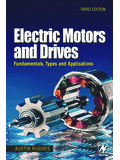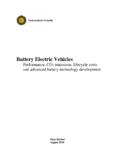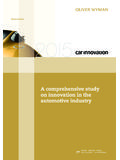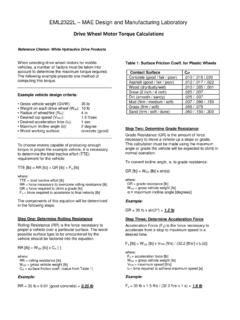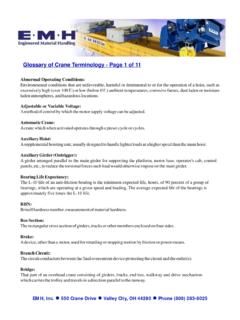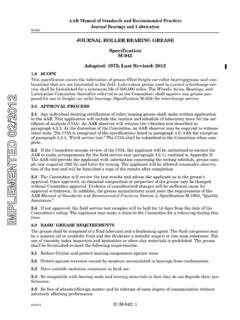Transcription of Electric Vehicle Conversion Design
1 1 Electric Vehicle Conversion Design2 Table of Contents Abstract & Introduction .. 3 Discussion & Results .. 4 Mechanical Design .. 4 Choosing a Vehicle to Convert .. 4 Electric motor .. 4 motor Controller .. 6 Power Steering and Brakes .. 7 HVAC Considerations .. 7 Vehicle System Monitoring .. 8 Electrical Design .. 9 Batteries .. 9 Charging .. 11 12 V Power Supply .. 12 Battery Monitoring System .. 12 Social Impact .. 15 Safety .. 16 16 References .. 17 Appendix .. 17 WarP9 motor Performance Curve .. 17 Design Calculations ..18-20 Trojan Battery Data .. 21 3 Abstract The Conversion process of an internal combustion engine to an Electric Vehicle powered by batteries comprises many steps from choosing the Vehicle , sizing a motor , and the type of batteries. This project takes a 1980 Datsun 280zx and converts it to an all Electric car with a DC motor and lead acid batteries.
2 The power steering and power assist are reused as well as air conditioning components. Key Words: Electric car, Peukert s effect, discharge rate Introduction Operating a battery Electric Vehicle will eliminate emissions inside our cities and reduce our dependence on oil. The energy used for our Electric transportation will be as diverse as the electrical grid obtaining energy from coal, natural gas, nuclear, and some renewable forms. The current Electric vehicles available have performances similar to high end sports cars and ranges over 100 miles per charge but remain cost prohibitive ($100,000 for the Tesla Roadster, $40,000 for the Chevy Volt) for most of the population. Converting an existing Vehicle to operate with an Electric motor and battery power can provide the majority of the population an all Electric commuter car for under $10,000. During the infancy of the automobile, Electric and gasoline vehicles competed for dominance of the market.
3 The all Electric Vehicle lost because of the lack of range from current battery technology. Until recently the Electric car was dormant. The number of Electric vehicles on the roads is increasing every year as people become more environmentally conscious and gasoline prices are volatile. 4 Figure 1: 1980 Datsun 280zx Discussion & Results Mechanical Design Choosing a Vehicle to Convert An Electric Conversion will act very similar to the Vehicle being converted. A gas guzzling SUV will have more room for batteries but it will be an electricity guzzling Vehicle . A small car will be more efficient but can t hold the batteries that a larger Vehicle can. The weight of the Vehicle will play a pivotal roll in deciding what motor to use and whether or not to use direct drive of a transmission. Rear wheel drive vs. front wheel drive will decide how the motor is mounted and can add complexity.
4 Newer vehicles have computers and modern electronics which may never work properly if the internal combustion engine is removed. Our project timeline consisted of only nine months to Design and construct so we chose a Vehicle to simplify the Conversion . We found a 1980 Datusn 280ZX on craigslist that fit our criteria. The engine was not running so the Vehicle was cheap but in overall good condition. It is a five-speed manual rear drive which allowed for a smaller motor to be used (larger motor required for direct drive ) and inline mounting. The electronics were simple, a drag coefficient, curb weight of 2800lbs, and enough room for the batteries. Electric motor Induction and direct current (DC) are the two families of Electric motors typically used in Electric vehicles each having their pros and cons.
5 The induction motor works on alternating 5 Figure 2: WarP 9 motor current (AC) power and is controlled using a variable frequency drive (VFD). These motors come in all different sizes and can provide all of the horsepower and torque needed for any Conversion . Because of how they function, they naturally lend themselves to regenerative braking using the motor to stop the car (not completely, physical brakes are needed even with regenerative breaking) and recharge the batteries. Drawbacks of induction motors are their cost where some systems can reach upwards of $25,000. DC motors are more common and the cost of comparable power motors makes them more attractive than induction motors. These motors fall into two categories of permanent magnet (PM) and series DC. PM have the advantage of regenerative breaking much like the induction motor .
6 Choosing a motor will depend on the weight and aerodynamics of the car. The starting torque required to move our Vehicle in first gear with an estimated end weight of 3200lbs is 72 ft-lbs (see calculations in Appendix 2). The torque needed to maintain a speed of 65mph in 5th gear is 52 ft-lbs. Based on these calculations we chose the series DC motor WarP9 from Warfield Electric (see performance curve in Appendix 1). The motor has the toque to move our Vehicle , is specifically made for Electric vehicles, and has a dual shaft for accessory mounting. Grassroots Electric Vehicles ( ) sells this motor for $1670 making it cost competitive with alternative motors in its same class. 6 The WarP9 weighs 158 lbs, has a 9 diameter and is 15 long. The length and diameter of the motor made fit well with our 280zx. The drive end shaft is coupled to the flywheel taken off of the original motor .
7 A clutch disc is mounted to the flywheel as it was in the original Vehicle and is set inside the bell housing of the transmission. A cover plate was built and the motor is attached to it via a motor cage built from aluminum angle. The commutator end of the motor is mounted to a cross member of the Vehicle frame just inside of where the original ICE was mounted. Rubber pads are placed beneath every mount to isolate some of the vibrations. A brace was added to help support the bell housing of the transmission as well. motor Controller The controller has to meet the capacity of the motor being used. Our motor has a voltage limit of 192V and the OEM recommends nothing over 170V. Voltage on the motor is directly proportional to the RPMs of the motor and amperage has a nonlinear relationship to torque . Several companies manufacture DC motor controllers: Curtis, Alltrax, Kelly Controls, and Caf Electric .
8 The Zilla controller made by Caf Electric was our first choice because of its price and power capabilities. Because they price the controller to affordable to people doing these conversions, they are highly sought after and there is a waiting list. We chose the Kelly controller KDH14650, which will have a power output capability of 144V and 250 amps continuous for $1,300. The motor controller can limit the performance of the motor and therefore the Vehicle if it is sized too small. The Kelly controller is mounted to an aluminum sheet to aid heat dissipation which is recommended by the OEM. A 500 amp fuse and a main contactor are mounted to the same board. Two LED indicator lights from the controller are mounted in the dash display next to a 7 guide for easier troubleshooting from inside the cabin. An RS232 cable is used to change the settings of the controller such as under or over voltage of the battery pack, throttle type, current limitations which is also mounted on the driver side cabin near the floor for easy reprogramming from inside the cabin.
9 Power Steering and Brakes Our original Vehicle had power steering and brakes. While removing the ICE we saved the power steering pump and mounted it onto the driver s side motor cage. An accessory pulley and belt provide the power just as it was in the original setup. One drawback is that the car does not have power steering when the motor is not moving unlike an ICE idling at 700 rpm. The vacuum assisted brake is solved using a separate 12V vacuum pump commonly used for high horsepower engines. A PVC tank mounted by the driver side headlight stores vacuum and a switch will turn on and off our pump keeping 14 to 17 inHg vacuums. HVAC Considerations Free heat that is a normal by product of a 20-30% efficient gasoline engine cannot be totally replaced. Electric Vehicle conversions such as this would not be ideal for colder climates where this heat is essential.
10 Our project uses three 12V 156 watt heaters to provide some heat and a windshield defroster. A heater is mounted under the dash on the driver side and on the passenger side. The third is mounted where the heater core used to be. It is highly recommended that if the heater core is not being used that it be removed because they will smell after some time if left dormant. This Vehicle is going to be a commuter car in the hot climate of the American Southwest where air condition is critical in summer heat. The air compressor, condenser, and air conditioning components were salvaged from the original engine. The compressor is mounted to 8 the passenger side motor cage and is powered by the same accessory pulley as the power steering pump. The whole system was rerouted using soft copper tubing and fittings. One option that was considered was to run a separate smaller motor for the sole purpose of providing power for the air compressor.
